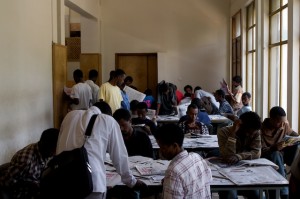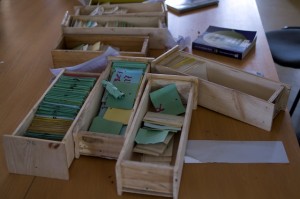Bahir Dar Meetings Continued
4 March. Marlene offers the following report, through which I’ve interspersed some additional observations:
Today we met first with the Head Librarian of Bihar Dar University, Getachre Setotaw to follow up his offer to learn about the library system and services. There was no power on campus due to a scheduled 9-hour outage, and many students and faculty were therefore strolling the campus grounds.

Ato Gertahchew toured us through the post-graduate library, the main library, and the business library. Knowing our interest in digital technologies, he remarked upon the library’s planned digitalization project of the print journal collection, acquisitions and cataloging projects using the open software, Greenstone, and showed us the computer labs (there were two with about 10 computers each). The library is beginning to digitize all masters and PhD theses and many are already available on the library website. Both AAU and BDU have worked to digitize their library catalogues. BDU still uses the Dewey Decimal system while Addis Ababa University has converted to Library of Congress with the except of its Amharic collection. Both retain card catalogues for days such as this, when power is down. (And it should be noted that such days are the rule rather than the exception. At this time Ethiopia is facing serious challenges due to the collapse of a main water tunnel in the primary hydroelectric project. Power was down every day during our visit, often several times a day, for periods ranging from 10 minutes to several hours.)

We were then escorted to the Department of English Language Education and met by Dr. Abiy Yegzaw and Ato Zelalem Gefnef, a brilliant and enthusiastic academic who lectures in the department and recently completed a master’s degree in multiculturalism at Addis Ababa University. Other faculty later joined the discussion, Ato Tesfaye Tilahun, Head of Department, Dr. Mulugeta Teka, Ato Dawit Amogne, and Ato Yinager Teklesillaise (both lecturers). The conversation evolved as faculty members joined us over the course of an hour. Our discussions about education in multilingual contexts from the day before were taken up with great interest and we explored the commonalities between Canadian and Ethiopian schooling and teacher education in this area. In Ethiopia, for example, Canada is well known for its bilingual policies in education, and particularly for the French immersion program. What is less known is the extent of multilingualism and the constituent groups of that population (First Nations, immigrants, migrants, refugees). Our Ethiopian colleagues had no idea, for instance, that there are dozens of indigenous languages in Canada apart from the languages of immigrant groups, and they were unaware of language preservation projects that parallel some of their own initiatives. We were keen to learn of each other’s initiatives in this regard.
Our colleagues at BDU spoke of the growing awareness of the rights of children from all language groups in Ethiopia (approximately 80) to learn in their first language. They explained the complexity of this issue: it is important to preserve language and culture, and yet it is also important to give children access to the language of commerce, which is English. They emphasized that research in this area is greatly needed, but is as yet in its infancy.
Ultimately, Ato Tesfaye Telihun reiterated BDU’s desire to consider how a strong program addressing some of the above issues might be developed employing mixed-mode instructional approaches. We drafted a document toward this end, which our colleagues will revise and expand in the next days.